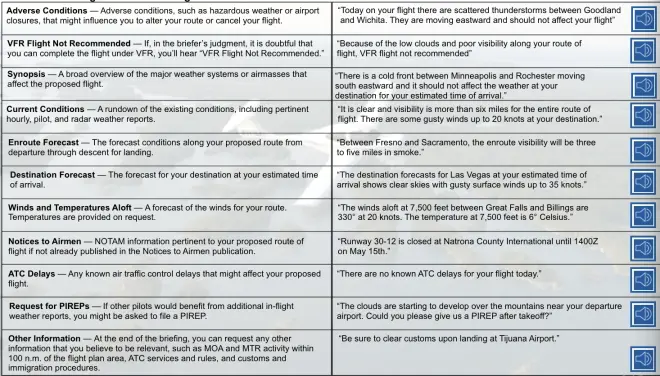飞行课程 Stage 2 - Sources of Weather Information

Content:
Weather Briefings
In-Flight Weather Sources

1. Weather Briefings
Preflight Weather Briefing Requests
When requesting a briefing, identify yourself as a pilot, and supply the briefer with the following information:
Type of flight planned (VFR or IFR)
Aircraft number or your name
Aircraft type
Departure airport
Route of flight
Destination
Flight altitude
Estimated time of departure (ETO)
Estimated time enroute (ETE)
Types of Preflight Weather Briefings
Outlook briefings - provide forecast information (when the departure time is six or more hours away)
Standard briefings - most complete and assume you have no familiarity with the overall weather picture

Abbreviated briefings - provide updates from a previous briefing or other weather source or fill in missing items from the weather picture you have
2. In-Flight Weather Sources
Flight service stations (FSS)
Center Weather Advisories (CWAs)
Unscheduled weather advisory issued by an ARTCC to alert pilots of existing or anticipated adverse weather conditions within the next two hours
A CWA might be initiated:
When a SIGMET has not been issued, but based on PIREPS, conditions meet those criteria
To supplement an existing in-flight advisory
To alert pilots to conditions that currently or will soon adversely affect the safe flow of traffic
ARTCC broadcast these reports once on all frequencies except emergency frequencies when any part of the area described is within 150 miles of their airspace; in terminal areas, local controls such as towers and approach and departure control will broadcast these reports for conditions within 50 miles of their airspace
Automated weather Observing systems (AWOS)

Automated Surface Observing System (ASOS)
ASOS provides:
Cloud height and amount up to 12,000 feet
Visibility and obstructions to vision, such as fog and haze
Type, intensity, and amount of precipitation
Pressure, including sea-level pressure and altimeter setting
Ambient and dew point temperatures
Wind direction, speed, and character (gusts, squalls)
Does not report clouds above 12,000 ft., virga, tornadoes, ice crystals, snow pellets, drizzle, or blowing obstructions such as snow, dust, or sand, and cannt detect oncooming storms

